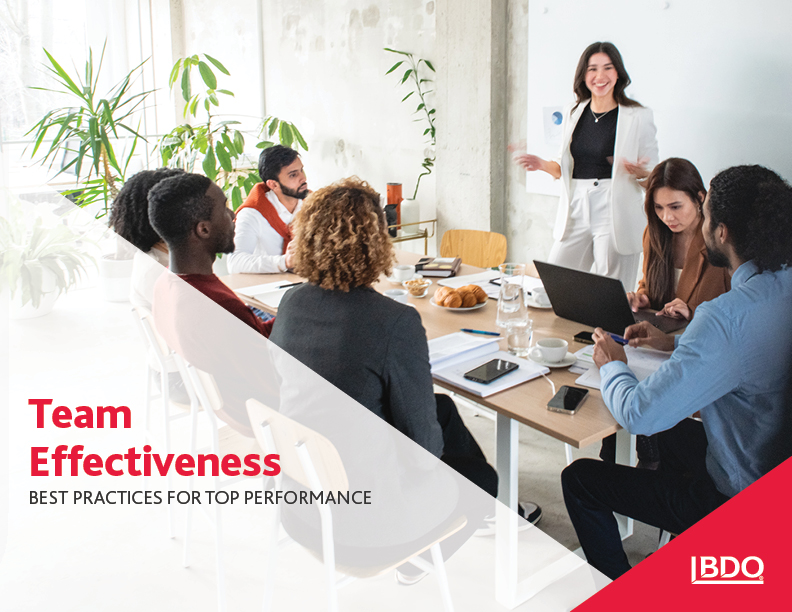Have you ever been a part of a rock star team?
What did it feel like?
Was it fun? Collaborative? Engaging? Did everyone understand their roles and know what was expected of each other? Did you consistently meet or exceed your goals? Did you feel like you were making a difference? Did you feel valued and appreciated? Were you able to be your authentic self?
If you answered yes, then you likely already have a good sense of what makes up an effective team, how it can improve your day-to-day work, and how it can lead to outcomes that are exciting to be a part of.
As a leader, you may already know how to spot the differences between a highly effective team and one that is not. Like many areas of business, team performance is easy to identify and an exciting piece of the employee experience but at the same time, it’s difficult to build and improve upon — especially without a plan in place.
In this article, we share a few opportunities to develop and nurture team effectiveness.

Discover the strategic practices that drive collaboration, trust, and high performance. This insight helps leaders and teams build the kind of culture where people thrive and results follow.
What Is an Effective Team?
Team effectiveness, also referred to as team performance, is the capacity of a group of people, usually with complementary skills, to work together to achieve its goals and objectives. Team effectiveness means that people collaborate in ways that amplify their strengths, and that their collective, combined efforts far outweigh the individual contributions that any one person brings to the table. Leaders of highly effective teams understand and leverage each person’s individual strengths, foster growth mindsets and smart risk-taking, and help everyone see the big picture.
High-performing teams have a culture rooted in Deep Trust and High Expectations™. This kind of environment creates the conditions for people to do their best work and for the entire team to thrive.
Why Is Team Effectiveness Important?
Team effectiveness matters because high-performing teams deliver results, and it’s what your employees want. Nine out of 10 employees surveyed in BDO’s Winning on the People Side of Business™ report agree: effective collaboration is important to their organization’s culture. When deep trust and high expectations work together, businesses can see significant boosts in ROI. In fact, research shows that highly aligned companies grow revenue 58% faster and are 72% more profitable while significantly outperforming their unaligned peers in terms of leading teams and engaging employees.
How Deep Trust and High Expectations® Cultures Create Effective Teams
High-performing teams don’t just appear, and you can’t throw a bunch of star performers together and automatically hope the team wins. Team effectiveness has to be nurtured and developed, with vision from leaders and motivated employees.
Our Deep Trust and High Expectations™ essential practices are the foundation of the team effectiveness models that we develop for our clients. When they work in tandem, organizations build teams that strive, learn, support, challenge, and achieve more together. Compare these best practices with how you currently define effective teams in your business. What’s missing, and where can you improve?
When the elements of both deep trust and high expectations are present, you end up with a virtuous cycle of meaning, learning, impact, and motivation across the team and organization.
How to Build an Effective Team
So, now that you know what team effectiveness is, why it’s important, and what it looks like in the workplace, let’s dive into 8 areas you can work on to build one.
A team is only as good as the person coaching it. The right leadership enhances a team’s success, but too often, people are placed in leadership roles without proper training. It’s vital to take advantage of every opportunity to uplevel your people management skills when building effective teams. Request regular feedback from each of your direct reports, as well as your manager, to identify your leadership strengths and weaknesses. Learn how to lead with empathy, develop strong communication skills to ask pertinent questions to understand and be able to disseminate organizational strategy and objectives.
Our clients have continuously told us how important it is to skill up their people managers, but many of them indicated that they had a hard time finding the right program for their unique organization. To address this need, we developed Best Boss™, an immersive, facilitated learning experience for people managers that equips them with the mindset and capabilities to unleash their people’s potential and lead engaged, high-performing teams.
The key to developing your leadership skills is to focus on skills that every manager, regardless of personality, needs to have, including:
- A growth mindset
- Empathy and high emotional intelligence (EQ)
- Robust communication skills
- Agility, flexibility, and reliability
- Ability to receive and give constructive feedback
- Sharp decision-making skills
Team effectiveness depends on achieving goals, and the SMART framework can help. “SMART” stands for Specific, Measurable, Achievable, Relevant, and Time-Bound. Using this approach can help your team stay accountable, eliminate generalities and guesswork, set a clear timeline, and make it easier to track progress and identify missed milestones.
SMART goals are:
- Specific: Well-defined, clear, and unambiguous.
- Measurable: With specific criteria that measure your progress toward the accomplishment of the goal.
- Achievable: Attainable and not impossible to achieve.
- Relevant: Meaningful and relevant to your purpose.
- Time-Bound: With a clearly defined timeline, including starting and target dates, that creates urgency around the project and keeps everyone on track.
Finding meaning in work is about making sure your teams are motivated to innovate, create, and propel the organization forward. People who are passionate and inspired help fuel team effectiveness because they deeply understand how their work contributes to the organization’s overall success and objectives.
As a leader, it’s your job to help your employees and teams find meaning in their work, by having discussions around the “why” of your team’s tasks. Have them meet with customers (both internal and external) and learn how their work affects their lives or jobs. Demonstrate your own sense of purpose by extending a helping hand and become a positive “force for good” in your workplace and among your team. Whenever possible, look for areas of opportunity to increase skill sets and recognize when team members are improving. Pair people together so they can build relationships, create trust, and deepen connections.
Teams function most efficiently and productively when roles and responsibilities are clearly defined, and members share a common understanding of those roles and responsibilities. There is less duplication of effort, confusion, disappointment, and frustration.
Understanding roles and responsibilities also helps build trust and respect among team members because they learn to value the contributions of their colleagues, and everyone has greater transparency into the overall process. In this context, when recognizing the team’s collective success, you further strengthen shared responsibility and ownership, reinforcing the trust and respect throughout the group.
As a leader, it’s important to leverage your employees’ networks by actively seeking employee referrals and encouraging team members to recommend candidates. Involve your team in the hiring process by soliciting their input or organizing panel interviews to help them get to know prospective hires. Current employees can be outstanding organizational ambassadors, and potential candidates are more likely to view a current employee’s perspective as authentic. A current employee also knows the company culture and opportunity areas and can spot people with the qualities and skills that will best complement the team.
Empowering your team to participate in recruitment can lead to better, and faster hiring decisions.
Good communication is a core leadership function and a key characteristic of a good leader. Effective communication and effective leadership are closely intertwined, and they can make, or break, teams. Be purposeful and intentional about your communication strategy, and tailor your style to meet the needs of your team. Be accessible and approachable, whether in person or online. Maintain an open-door policy by encouraging team members to reach out to you anytime—whether through face-to-face conversations, video calls, or instant messaging.
For important communications initiatives, consider campaigns that leverage tactics beyond just internal emails, such as videos, print materials, digital signage, and strong visuals (check out BDO’s Human, Compelling, Visual Communications™ approach to learn more).
So, before sending another email, ask yourself if there’s a more engaging way to communicate. Practice active listening and allow people to give you constructive feedback without fear of reprisal or judgment. Ask questions and don’t be defensive. Focus on what you’re contributing to conversations to help you learn more about your team’s work and how you can help. Keep it simple and follow through with actions.
Strong professional relationships are the foundation of high performing teams. Investing time and energy in these connections is critical to developing a Deep Trust and High Expectations® culture. Once you and your team genuinely trust and respect each other, regular, honest dialogue about individual and team performance can increase, driving greater team effectiveness.
Prioritize authentic connections with your employees and teams to help ensure outstanding performance by leading with empathy and emotional intelligence. This can help engage and inspire your people by creating bonds that are enduring and reliable. Model collaborative behaviors and actively seek feedback to continuously elevate team performance. Build a relationship model that is memorable, unique to your organization, and suited to your team’s strengths and weaknesses. Adopt a coaching and community mindset and seek out opportunities to break down barriers and obstacles that stand in the way of your team’s success.
It goes without saying (but we’re saying it anyway) that the best investment your organization will ever make is in your employees and teams. Investing in team development helps improve manager and employee relationships and helps team members connect to one another. It will also help strengthen communication and nurture your future leaders. Potential candidates are drawn to high-performing teams, and seeing an earnest commitment to team development can help retain the top talent you already have. And let’s not forget that a highly effective team is a competitive advantage.
Create Effective Teams with Experienced Professionals on the People Side of Business
While building a high-performing team may sound straightforward, our research demonstrates that the reality is more challenging — while 91 percent of surveyed employees regard effective collaboration as important, only 22 percent of individual contributors agree their organization is doing a good job in that area.
If you’re unsure where to begin, partnering with experienced professionals can provide the guidance and tools your teams need to excel in today’s complex business environment.

SHARE